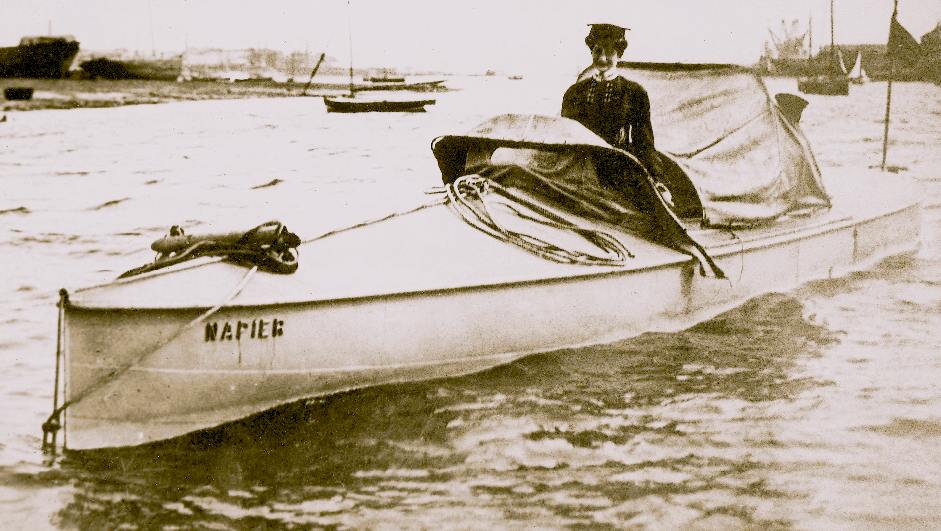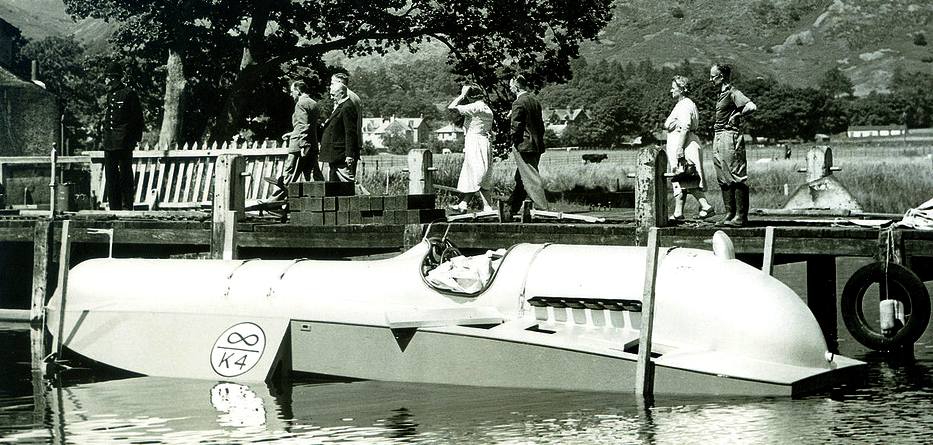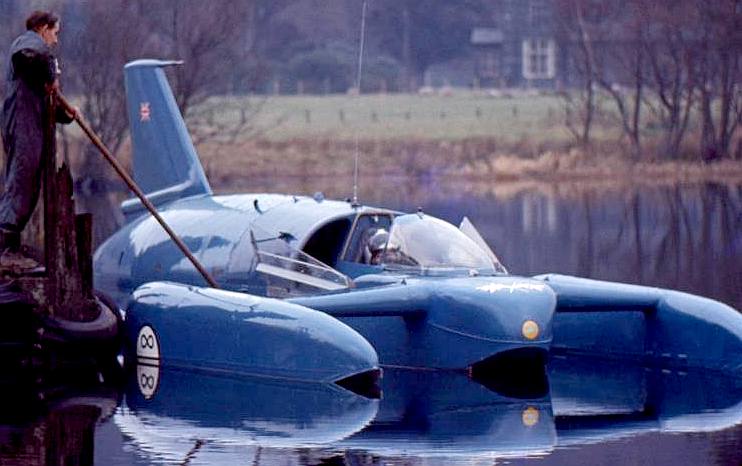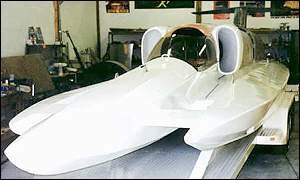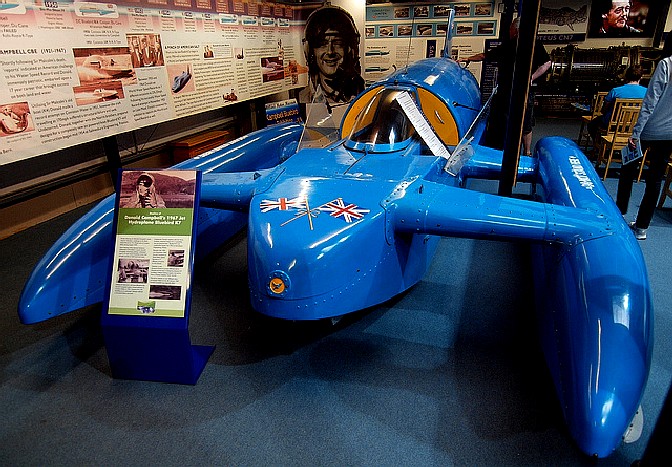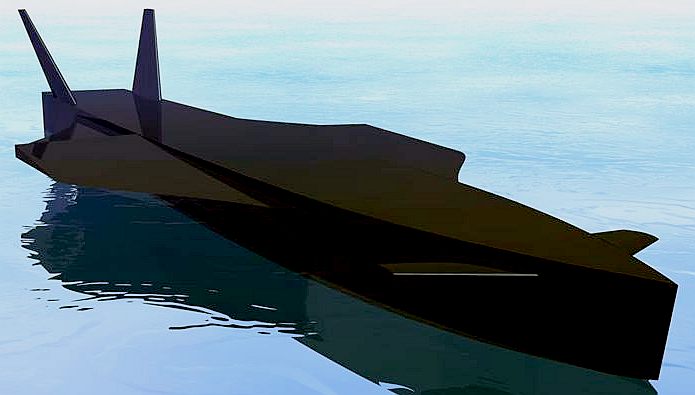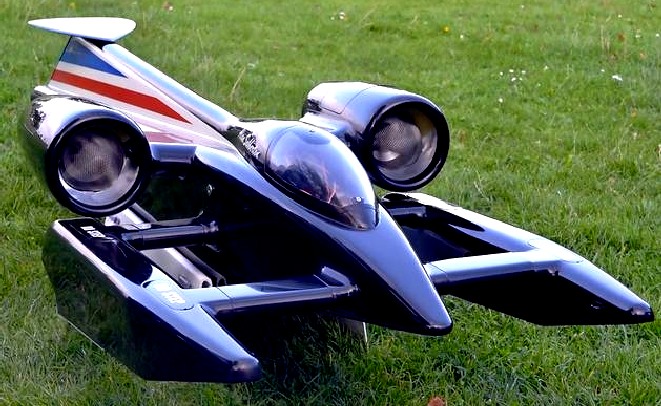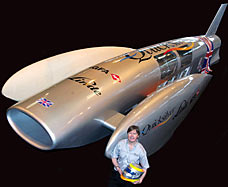|
WATER SPEED RECORDS
|
|||||||||||||||||||||||||||||||||||||||||||||||||||||||||||||||||||||||||||||||||||||||||||||||||||||||||||||||||||||||||||||||||||||||||||||||||||||||||||||||||||||||||||||||||||||||||||||||||||||||||||||||||||||||||||||||||||||||||||||||||||||||||||||||||||||||||||||||||||||||||||||||||||||||||||||||||||||||||||||||||||||||
|
The World Unlimited water speed record is the officially recognised fastest speed achieved by a water-borne vehicle. The current record of 511 km/h (317 mph) was achieved in 1978 by Ken Warby. His son Dave Warby is set to attempt to break his father's record in Spirit of Australia 2 at some point in the future.
* From 1909 to 1927 the record was an unofficial listing from the organisers of powerboat races.
* In 1928 the record category was officially established.
* From 1930 the rules of the record stipulated that a craft must make two runs over a timed kilometre course in opposite directions, with the record being the average speed of the two runs.
The record is currently ratified by the Union Internationale Motonautique (UIM). With an approximate fatality rate of 50%, the record is one of the sporting world's most hazardous competitions.
1910s
Beginning in 1908, Alexander Graham Bell and engineer Frederick W. "Casey" Baldwin began experimenting with powered watercraft. In 1919, with Baldwin piloting their HD-4 hydrofoil, a new world water speed record of 70.86 mph was set on Bras d'Or Lake in Nova Scotia.
1920s
During the 1920s powerboat racing was dominated by American businessman and racer Gar Wood, whose Miss America boats were capable of speeds approaching 160 kilometers per hour (100 mph). Increased public interest generated by the speeds achieved by Wood and others led to an official speed record being ratified in 1928. The first person to try a record attempt was Gar Wood’s brother George. On 4 September 1928 he drove Miss America VII to 149.40 km/h (92.83 mph) on the Detroit River. The next year Gar Wood took the same boat up a waterway Indian Creek, Miami and reached 149.86 km/h (93.12 mph).
1930s
Like the land speed record, the water record was destined to become a scrap for national honour between Britain and the USA. American success in setting records spurred Castrol Oil chairman Lord Wakefield to sponsor a project to bring the water record to Britain. Famed land speed record breaker and racing driver Sir Henry Segrave was hired to pilot a new boat called Miss England. Although the boat wasn’t capable of beating Gar Wood’s Miss America, the British team did gain experience that they put into an improved boat. Miss England II was powered by two Rolls-Royce aircraft engines and seemed capable of beating Wood’s record.
On July 13, 1930, Segrave drove Miss England II to a new record of 158.94 km/h (98.76 mph) average speed during two runs on Windermere, in Britain’s Lake District. Having set the record, Segrave set off on a third run to try to improve the record further. Unfortunately during the run, the boat struck an object in the water and capsized, with both Segrave and his co-driver receiving fatal injuries.
Following Segrave’s death, Miss England II was salvaged from the lake and repaired. Another racing driver, Kaye Don, was chosen as the new driver for 1931. However, during this time Gar Wood recaptured the record for the US at 164.41 km/h (102.16 mph). A month later on Lake Garda, Don fought back with 177.387 km/h (110.223 mph). In February 1932, Wood responded, nudging the mark up by 1.6 km/h (1 mph).
In response to the continued American challenge, the British team built a new boat, Miss England III. The design was an evolution of the predecessor, with a squared-off stern and twin propellers being the main improvements. Don took the new boat to Loch Lomond in Scotland, on July 18, 1932, improved the record first to 188.985 km/h (117.430 mph), and then to 192.816 km/h (119.810 mph) on a second run.
Determined to have the last word over his great rival, Gar Wood built another new Miss America. Miss America X was 12 metres long, and was powered by four supercharged Packard aeroplane engines. On September 20, 1932, Wood drove his new monster-boat to 200.943 km/h (124.860 mph). It would prove to be the end of an era. Don declined to attempt any further records, and Miss England III became a museum piece. Wood also opted to scale-down his involvement in racing and returned to running his businesses. Somewhat ironically, both of the daredevil record-breakers would live to their 90s. Wood died in 1971, and Kaye Don in 1985.
Boat design changes
Wood’s last record would be one of the final records for a conventional, single-keel boat. In June 1937, Malcolm Campbell, the world-famous land speed record breaker, drove Bluebird K3 to a new record of 203.31 km/h (126.33 mph) at Lake Maggiore. Compared to the massive Miss America X, K3 was a much more compact craft. It was 5 metres shorter and had one engine to X's four. Despite his success, Campbell was unsatisfied by the relatively small increase in speed. He commissioned a new Bluebird to be built. K4 was a ‘three pointer’ hydroplane. Unlike conventional powerboats, which have a single keel, with an indent, or ‘step’, cut from the bottom to reduce drag, a hydroplane has a concave base with two floats fitted to the front, and a third point at the rear of the hull. When the boat increases in speed, most of the hull lifts out of the water and runs on the three contact points. The positive effect is a reduction in drag and an increase in power-to-weight ratio - the boat is lighter as it doesn’t need many engines to push it along. The downside is that the three-pointer is much less stable than the single keel boat. If the hydroplane’s angle of attack is upset at speed, the craft can somersault into the air, or nose-dive into the water.
1940s
Campbell’s new boat was a success. In 1939, on the eve of the Second World War, he took it to Coniston Water and increased his record by 18 km/h (11 mph), to 228.11 km/h (141.74 mph). The return of peace in 1945 brought with it a new form of power for the record breaker – the jet engine. Campbell immediately renovated Bluebird K4 with a De Havilland Goblin jet engine. The result was a curious-looking craft, whose shoe-like profile led to it being nicknamed ‘The Coniston Slipper’. The experiment with jet-power was not a success and Campbell retired from record-attempts. He died in 1948.
1950s. Slo-Mo-Shun and Bluebird: Propriders to Turbojets
Early in the morning of June 26, 1950, a small red boat skipped across Lake Washington, near Seattle, and improved on Campbell’s record by 29 km/h (18 mph). The boat was called Slo-Mo-Shun-IV, and it was built by Seattle Chrysler dealer called Stanley Sayres. The piston-engined boat was able to run at 160 mph because its hull was designed to lift the top of the propellers out of water when running at high speed. This phenomenon, called ‘prop riding’, further reduced drag.
In 1952, Sayres drove Slo-Mo-Shun to 287.25 km/h (178.49 mph) - a further 29 km/h (18 mph) increase. The renewed American success persuaded Malcolm Campbell’s son Donald, who had already driven Bluebird K4 to within sight of his father’s record, to make a push for the record. However, the K4 was completely out-classed and Campbell could not run at the speeds of the Seattle-built boat. In 1951 K4 was written-off when it hit a submerged object on Coniston.
At this time, yet another land speed driver entered the fray. Englishman John Cobb, was hoping to beat 320 km/h (200 mph) in his jet-powered, all-aluminium built Crusader. A radical design, the Crusader reversed the ‘three-pointer’ design, placing the floats at the rear of the hull. On September 29, 1952, Cobb tried for a 320 km/h (200 mph) record on Loch Ness. Travelling at an estimated speed of 386 km/h (240 mph), Crusader's front plane collapsed and the craft instantly disintegrated. Cobb was rescued from the water but died of shock soon afterward.
Two years later, on October 8, 1954, another man would die trying for the record. Italian textile magnates Mario Verga and Francesco Vitetta, responding to a prize offer of 5 million lire from the Italian Motorboat Federation to any Italian who break the world record, built a sleek piston-engined hydroplane to claim the record. Named Laura, after Verga’s daughter, the boat was fast but unstable. Traveling across Lake Iseo at close to 306 km/h (190 mph), Verga lost control of Laura, and was thrown out into the water when the boat somersaulted. Like Cobb, he died of shock.
Following Cobbs death, Donald Campbell started working on a new Bluebird - K7, a jet powered hydroplane. Learning the many lessons from Cobb’s ill-starred Crusader, K7 was designed as a classic 3 pointer with sponsons forward alongside the cockpit.
The 26ft long, 10ft wide, 5 ft high, 2.5 ton craft was designed by Ken and Lewis Norris in 1953-54 and was completed in early 1955. It was powered by a Metropolitan-Vickers Beryl turbojet of 3500lbs thrust. K7 was of all metal construction and proved to have extremely high rigidity.
Campbell and K7 set a new record of 325.60 km/h (202.32 mph) on Ullswater in July 1955. Campbell and K7 went on to break the record a further six times over the next nine years in the USA and England (Lake Coniston), finally increasing it to 444.71 km/h (276.33 mph) at Lake Dumbleyung in Western Australia in 1964. Donald Campbell thus became the most prolific water speed record breaker of all time.
1967
Donald Campbell arrived back at Coniston Water, scene of previous triumphs, in November 1966. Bluebird K7 had been re-engined with a Bristol-Siddeley Orpheus jet rated at 4500lbs thrust. His stated aim was to bump the record out of reach of the Americans, and push it beyond 300mph (480kph) The new attempt suffered many setbacks both mechanical, and weather related, and time by the end of 1966, Campbell existing 276mph record was still not broken. On the morning of January 4, 1967, he was a man under pressure, but the day dawned still, and conditions seemed perfect.
Bluebird K7 was over a decade old, and an American called Lee Taylor was threatening the record with a new boat, Hustler. The patriotic Campbell desperately wanted a Briton to be the first to break 480 km/h (300 mph). His first run across the lake was untroubled and fast. K7 averaged 475.2 km/h (297.6 mph). A new record seemed in sight. Campbell applied K7's water brake to slow the craft down from her peak speed of 315mph as she left the measured Kilo. The wake caused by the water brake was very large from traveling at such high speeds, so Campbell would normally refuel and wait, before starting the mandatory return leg, for the lake to settle again. This time, perhaps fearing that conditions would deteriorate if he waited, Campbell immediately turned around at the end of the lake and began his return run, to try and beat his own wash. Bluebird came back on her return even faster. At around 512 km/h (320 mph), just as she entered the measured Kilo, Bluebird met its wake from the first run. The boat began to lose stability, and finally, 100m before the end of the Kilo, its nose lifted at a 45 degree angle. The boat took off, somersaulted and then plunged nose-first into the lake, breaking up as she cart-wheeled across the surface. Campbell was killed instantly. Prolonged searches over the next two weeks located the wreck, but it was not until May 2001 that Campbell's body was finally located and recovered. Campbell was laid to rest in the churchyard at Coniston on the 12 September 2001
Lee Taylor, a Californian boat racer, had first tried for the record in April 1964. His boat Hustler was similar in design to Bluebird K7, being a jet hydroplane. During a test run on Lake Havasu Taylor was unable to shut down the jet and crashed into the lakeside at over 100mph. Hustler was wrecked and Taylor was severely injured. He spent the following years recuperating, and rebuilding his boat. On June 30, 1967 on Lake Guntersville, Taylor and Hustler tried for the record, but the wake of some spectator’s boats disturbed the water, forcing Taylor to slow down his second run, and he came up 3.2 km/h (2 mph) short. He tried again later the same day and succeeded in setting a new record of 459 km/h (286.875 mph).
1970s >>>>>
Until November 20, 1977, every official water speed record had been set by an American or Briton. That day Australian Ken Warby broke the Anglo-American domination when he piloted his Spirit of Australia to 464.5 km/h (290.313 mph) to beat Lee Taylor’s record. Warby, who had built the craft in his back yard, used the publicity to find sponsorship to pay for improvements to the Spirit. On October 8, 1978 Warby travelled to Blowering Dam, Australia, and broke both the 480 km/h (300 mph) and 500 km/h barriers with an average speed of 510 km/h (318.75 mph).
As of 2005, Warby’s record still stands, and there have only been two official attempts to break it.
Lee Taylor tried to get the record back in 1980. Inspired by the land speed record cars Blue Flame and Budweiser Rocket, Taylor built a rocket-powered boat, Discovery II. The 40-foot long craft was a reverse three-point design, similar to John Cobb’s Crusader, albeit of much greater length.
Originally Taylor tested the boat on Walker Lake in Nevada but his backers demanded a more accessible location, so Taylor switched to Lake Tahoe. An attempt was set for November 13, 1980, but when conditions on the lake proved unfavourable, Taylor decided against trying for the record. Not wanting to disappoint the assembled spectators and media, he decided to do a test run instead. At 432 km/h (270 mph) Discovery II hit a swell and one of the floats collapsed, sending the boat plunging into the water. Taylor’s body and his destroyed craft were never recovered.
In 1989, Craig Arfons, nephew of famed record breaker Art Arfons, tried for the record in his all-carbon-fibre Rain X Challenger, but died when the hydroplane somersaulted at 483 km/h (301.875 mph).
Despite the high fatality rate, the record is still coveted by boat enthusiasts and racers. Currently there are three major projects aiming for the record. The British Quicksilver [1], The American Challenge project [2], and spurred into action by the new challengers, Ken Warby has also built a new boat [3].
In 2001, Bluebird K7 was raised from Coniston Water by members of the Bluebird Project.
K777
TEAM FOR GREAT BRITAIN
Record holders
Three times the power, but the same spirit of Bluebird - 9th December 2006
The 1967 footage of Donald Campbell's fatal attempt in Bluebird to claim the record has thrilled and appalled generations. The now famous blurred pictures show the jet-powered boat blasting across Coniston Water to a movie-tone style commentator. But as the speeding craft accelerates to 300mph it slowly arches into the air, gently flips and dives into the lake, spreading wreckage as it crashes back on to the water.
But the images have inspired one man who shares Campbell's need for speed - and now he plans to claim the record for himself and Britain in a 21st Century version of Bluebird which has all her spirit, but three times the horsepower.
Nigel will sit in a tiny bubble in one of Quicksilver's stabilizing floats
Racing enthusiast Nigel Macknight, 51, even hopes to pilot his £4 million boat Quicksilver into the record books on the same stretch of water in the Lake District where Campbell lost his life. And he knows that, after sacrificing his career, his most precious possessions and a 20-year relationship with his girlfriend in pursuit of his dream, he too could end up dead. "Who said it had to be easy to set a world record?" he said. "You've got to be willing to risk yourself, but you've also got to think about the possibility of being killed."
Macknight hopes the Quicksilver project will catch the nation's imagination. "There's an enormous amount of goodwill associated with the project because people have such fond memories of Bluebird." Only last week Campbell's daughter Gina launched a campaign to raise £750,000 to house a fully restored Bluebird at the Ruskin Museum in Coniston and she is backing the Quicksilver venture.
Macknight, a Formula 1 fan from boyhood, found his imagination was fired when, aged 17, he saw a documentary about Campbell. With a certain amount of youthful naivety, he decided he would get a new Bluebird project up and running. He worked on it for 18 months but eventually gave up. In 1978 he enviously watched news reports of Australian Ken Warby setting a new world record of 317.60mph, which still stands.
Macknight became a successful writer of technical manuals about aeronautics and it wasn't until 1999 that he relaunched his project, quitting his job and remortgaging his house. "I realised that if I was going to ask everyone else to put things into this project then I had to give it my all," he said. "I sold everything I had."
His sale of memorabilia, including an archive of Campbell's photographs and a watch given to him by astronaut Buzz Aldrin - and containing metal from the original lunar module - raised £12,000. But one of his buyers was so impressed by Macknight's enthusiasm that he introduced him to a sponsor - who backed him to the tune of £100,000.
More than 40 firms are now involved in building Quicksilver, which looks very similar to Bluebird but is packed with safety devices to protect the pilot and ensure it does not flip over like its predecessor as it speeds across the water at 350mph.
Macknight will lie virtually flat, gripping a steering wheel and using one pedal to accelerate and another to brake. The cockpit on the prototype was situated inside the fuselage but for the record attempt it will be located in one of Quicksilver's stabilising floats, enabling the engine to be moved forward.
Quicksilver's Rolls-Royce Spey engine came from a Hawker Siddeley Buccaneer aircraft. It will generate 25,000 horsepower - "more than the full grid of Formula 1 cars at full throttle", says Macknight - and is fuelled by a 105-gallon tank. The Bluebird generated up to 10,000 horsepower.
Looking ahead to his record attempt in 2008, Macknight is putting the dangers to the back of his mind. "The world has changed a heck of a lot since Campbell was killed," he said. "Then death was all part of the game. "Now it's not acceptable to have a death-or-glory approach. It will always be dangerous but you can't make it a reckless, cavalier thing. "Safety is of course paramount."
2010 DEPARTURE FROM JETS TO ELECTRIC BOATS >>>>
Jet powered boat record breaking all but ceased as a result of the many deaths, with a new breed of racers working to build the performance of electric and now solar powered boats. In 1994 Norman Boddy set one of the first electric boat records of 55.91 mph in a 144 volt runabout.
You can see more solar and electric water speed records HERE.
SOLAR CIRCUMNAVIGATION SPEED RECORD - The above table illustrates one of the most likely ocean awareness expedition routes showing the time elapsed in days for 7 knots average cruising speed, including times for 5 and 6 knot averages - allowing for 10% downtime and 36 days in ports.
Unlike most water speed record attempts, this is more concerned with endurance over long distances with relatively slow velocities. Apart from nuclear power, the only way to power a vessel over 24,000 nautical miles and more is using renewable energy sources. Hence, although the objective is to reduce the current solar powered circumnavigation water speed record from 584 days and 3mph average, the event in not an outright non-stop yacht competition in the offshore racing sense. It remains to be seen how accurate such a prediction might be.
An idea for an electric WSR contender floated (or rather not floated) in 2011, and sunk soon after - for no discernible reason - other than the boat was billed to run at 70mph, which was already 28mph too slow to take anything other than a few niche records. A real shame because the craft is quite a looker.
LINKS & REFERENCES
http://en.wikipedia.org/wiki/Water_speed_record Fred Harris and Mike Rimmer (2001). Skimming the Surface. Kevin Desmond (1996). The World Water Speed Record. Batsford. Leo Villa (1969). The Record Breakers.
Hamlyn.
|
|||||||||||||||||||||||||||||||||||||||||||||||||||||||||||||||||||||||||||||||||||||||||||||||||||||||||||||||||||||||||||||||||||||||||||||||||||||||||||||||||||||||||||||||||||||||||||||||||||||||||||||||||||||||||||||||||||||||||||||||||||||||||||||||||||||||||||||||||||||||||||||||||||||||||||||||||||||||||||||||||||||||
|
This
website is Copyright © 2019 Bluebird Marine Systems Limited.
The names Bluebird™, Solar Navigator™,
Ecostar DC50™, Utopia
Tristar™ and the blue bird in flight
|
